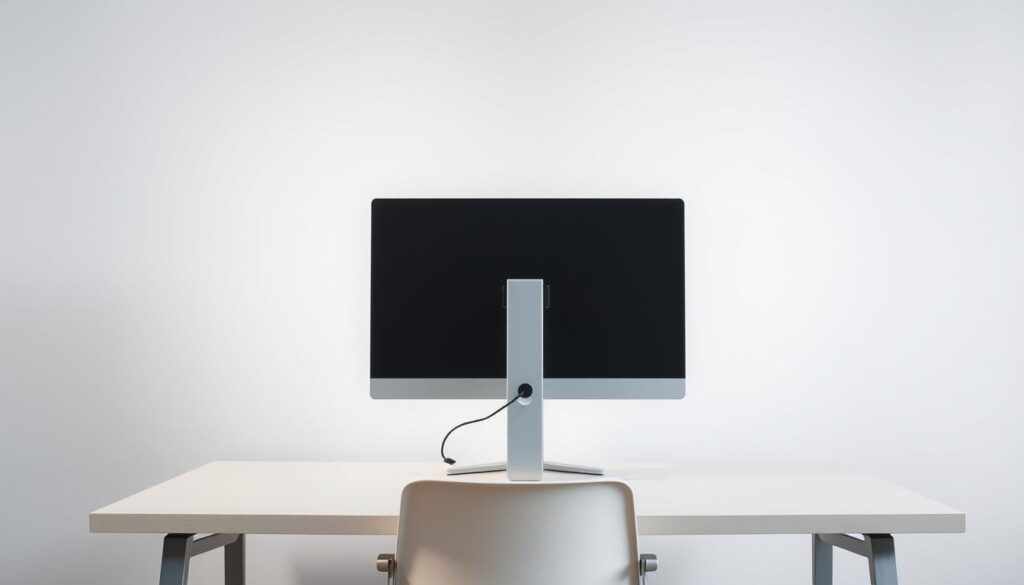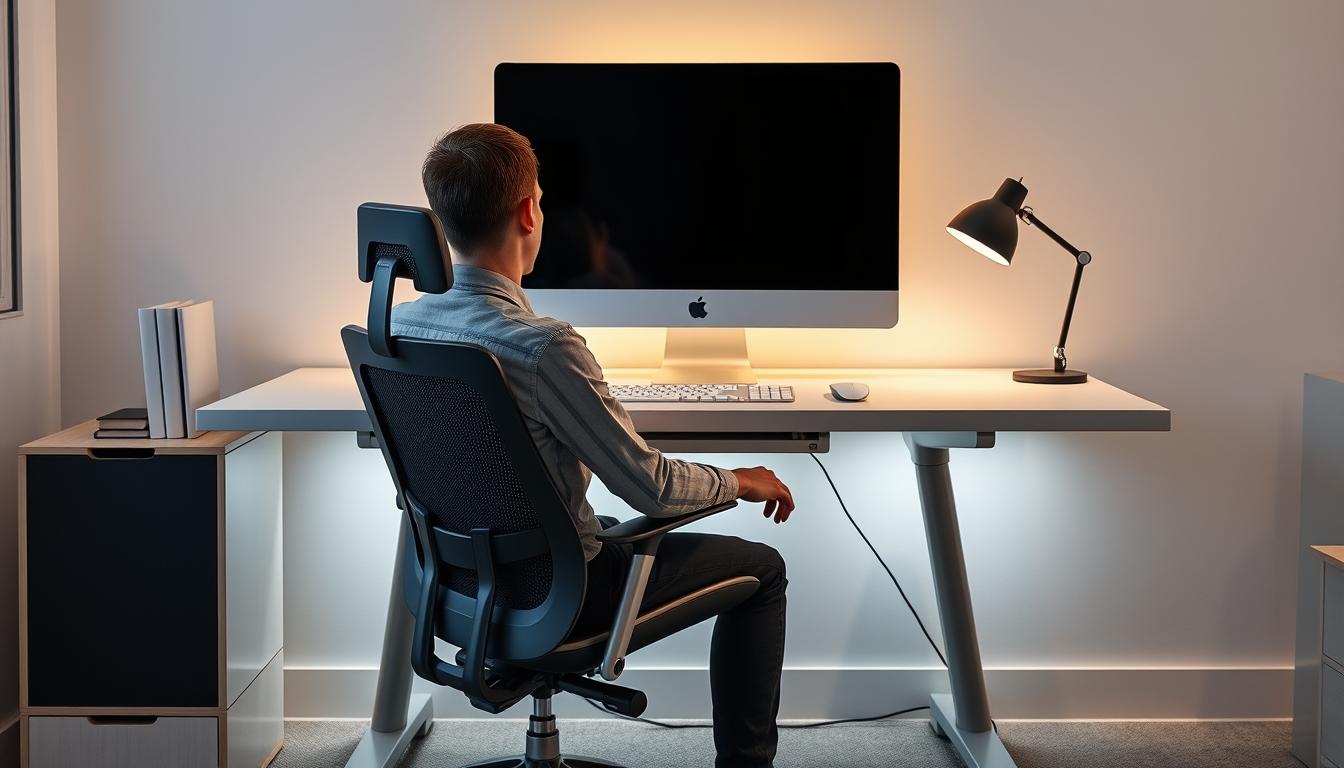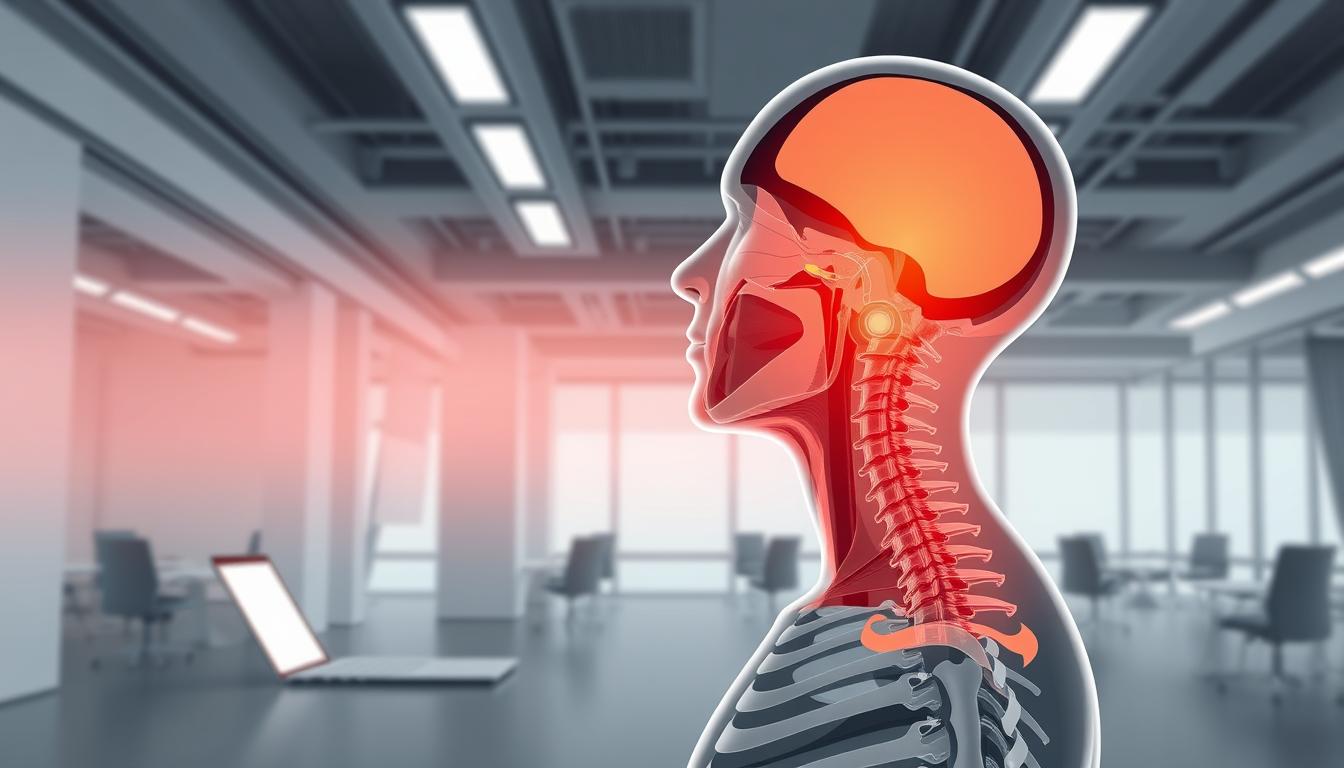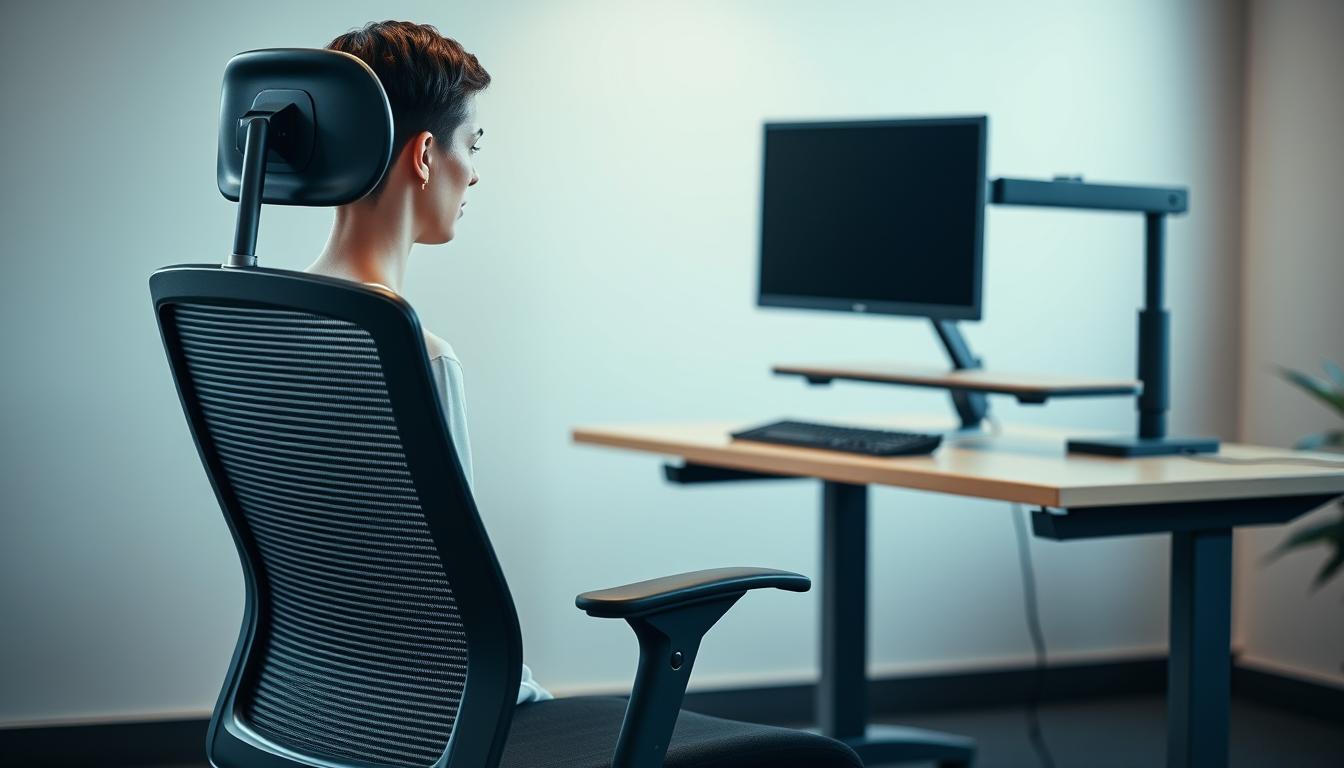In today’s fast-paced work environment, having a comfy and efficient workspace is key. The wrong angle of computer screens can cause neck strain. This article gives useful tips on screen angles to avoid neck pain. It highlights the value of correct office ergonomics. By using these tips, you can make your workspace healthier. This reduces the chance of muscle problems and makes work more enjoyable.
Understanding Neck Strain and Its Causes
Neck strain, often called tech neck, affects many people, especially in office settings. It causes neck pain and stiffness. Various factors lead to this discomfort.
Poor posture is a big cause, ruining the neck and spine’s alignment when sitting too long. If your desk and chair are not the right height, it only gets worse. Stress also adds to this, making the body feel tight and sore.
Knowing how your workspace affects your body is key to stopping neck issues. Making changes to how and where you work helps a lot. It makes you more comfortable and less likely to get tech neck.
The Importance of Ergonomics in the Workplace
Workplace ergonomics helps design spaces that meet employees’ physical needs. Making ergonomic changes can greatly improve employee health. Work areas that are not set up well can cause discomfort or injuries, especially for those who work at computers for long hours.
Buying ergonomic furniture and tools can boost productivity. Employees who are comfortable work better and are more focused and efficient. A workspace that reduces bodily strain can lead to better posture and fewer health problems in the future.
It’s important for any workplace to understand ergonomics to keep a healthy work culture. Putting ergonomics first helps create a happier work environment. This benefits both the workers and the company.
Screen Angle Tips to Prevent Neck Strain
Making sure your screen is at the right angle is key for neck health at work. Knowing the best screen height and distance is crucial for comfort every day. By using these tips, you can make your work area better for your neck and cut down on pain.
Optimal Screen Height and Distance
The best height for your monitor is at or just below where you look straight ahead. This lets you look forward naturally, which keeps you comfy all day. Try to keep your screen about an arm’s length away, or 60-70cm, to lessen strain. Following this advice helps your eyes stay relaxed and avoid discomfort.
Correct Monitor Positioning for Dual Screens
If you work with two screens, setting them up right is important for your neck. Arrange the monitors in a gentle V shape, with both at the same height. This setup is good for your neck when using two screens and helps keep your neck straight. By doing this, you can majorly cut down on neck pain if you sit for a long time.
Choosing the Right Office Chair for Neck Support
Finding the perfect office chair is key for keeping your neck healthy, especially if you sit for long hours. A good neck support chair must have adjustable settings to make sitting comfortable and ensure you sit correctly. It’s very important that your chair supports your body’s natural way of aligning.
Adjusting Chair Height and Support
Getting the office chair adjustment right means starting with your chair’s height. Your knees should bend at a 90-degree angle, and your feet should rest flat on the ground. This stops too much pressure on your neck and back. Also, your chair must have lumbar support to keep your lower back’s curve, giving crucial back support.
Benefits of Using an Ergonomic Chair
An ergonomic chair is made to give your body the support it needs, especially your neck and back. The benefits include:
- Making sitting for a long time more comfortable.
- Less neck and back pain by giving the right support.
- Being more productive because you’re more comfortable.
Choosing a great neck support chair is a big step towards a healthier working space and better health overall.
Adjusting Your Desk Height for Comfort
Adjusting your desk height is key to avoiding neck strain and staying comfy while you work. Your desk should be at a height that lets your forearms stay parallel to the ground as you type. This helps keep your posture right and stops you from leaning in, which can cause discomfort.
Changing your desk height now and then really helps your overall health. A sit-stand desk could be a great choice because it lets you switch between sitting and standing. This switch-up is good for your posture and lowers the risks that come with sitting too long. Sitting a lot can make your muscles tired and tense, especially around your neck and shoulders.
Making your desk setup ergonomic, meaning it fits your needs, is not just good for your body but also boosts how much you get done. Getting your desk height just right is an easy but powerful way to make working better for you.
Monitor and Accessory Placement for Eye-Level Alignment
Setting up your monitor correctly is key to keeping your eyes lined up right, which helps avoid neck and shoulder pain. Place your monitor so it’s at or just below eye level. Keep it about an arm’s length away to lessen eye strain and help you sit comfortably.
Using the right accessories can make your workspace even better. Items like adjustable laptop stands and document holders keep things at eye level. This arrangment helps you sit right and stay focused without feeling uncomfortable.
When using a keyboard and mouse, position them so your elbows are near your body, bent at a 90-degree angle. This setup isn’t just comfortable; it also promotes good posture all day long.

The Role of Regular Movement and Breaks
Moving regularly and taking breaks is key to staying well at work. Sitting for too long can cause neck strain, a problem for many office workers. Workplace breaks every hour help ease this strain. Getting up and doing some stretches makes a big difference in how comfortable you feel.
Adding movement during work boosts blood flow and lessens muscle weariness. Switching between sitting and standing keeps you sharp and engaged. Doing stretching routines aimed at your neck and shoulders eases tightness and increases flexibility.
Active breaks keep workers more productive and energetic all day. Sticking to these easy steps helps prevent neck pain and boosts workplace health.
Incorporating Exercise to Alleviate Neck Pain
Desk workers often struggle with neck pain due to long hours of sitting and bad posture. Making neck pain exercises a part of daily life can greatly ease this discomfort. Adding simple stretches like shoulder rolls and neck tilts can boost flexibility and lessen muscle tension. You can do these moves during work breaks.
To support the neck and back better, strengthening exercises are key. Taking part in physical therapy or fitness programs designed for desk workers can help a lot. These routines work on building core strength and fixing posture issues. By doing varied stretches regularly, you can tackle the pain that comes from sitting too much.
Conclusion
Creating a workspace that is easy on your neck is key to staying productive. Knowing why neck pain happens helps a lot. Proper screen placement and good chair support make a big difference. This setup not only reduces pain but also helps you focus and do your best work.
For the best results, moving around and taking breaks are crucial. Small habit changes and the right gear can enhance your work life greatly. When you invest in a comfortable work setting, you’re not just helping your body. You’re also becoming more efficient and happier at work.
In short, these efforts do more than just fix a problem temporarily. They make for a lasting, strain-free work environment. By sticking to these tips, employees can be healthier and more productive. This leads to a workplace where everyone is happier and works better.



